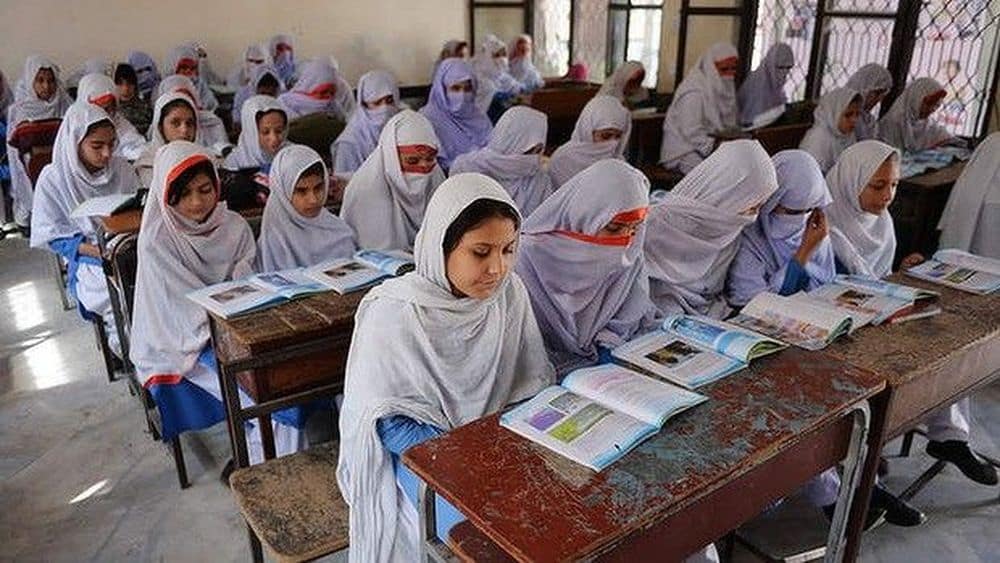Public Expenditure on education has decreased – as a percentage of GDP it is estimated to be 2.2 percent in the fiscal year 2017 as compared to 2.3 percent of GDP in the fiscal year 2016 – while literacy rate declined from 60 percent to 58 percent, revealed the Economic Survey 2017-18.
The education-related expenditure increased by 5.4 percent to Rs 699.2 billion in the fiscal year 2017, up from Rs 663.4 billion in the fiscal year 2016. The provincial governments are also spending a sizeable amount of their Annual Development Plans (ADPs) on education. The survey noted that during 2017-18, PSLM survey was not conducted due to Population & Housing Census 2017. Therefore the figures for the year 2015-16 may be considered for the current year.
The data shows that literacy remains much higher in urban areas (74 percent) than in rural areas (49 percent) with male (81 percent) and female (68 percent) in urban areas. Province-wise data suggests that Punjab and Sindh lead with 62 percent and 55 percent literacy rates respectively, followed by Khyber Pakhtunkhwa with 53 percent and Balochistan with 41 percent.
ALSO READ
Govt Allocates Rs 1.1 Billion for Artificial Intelligence Projects in 6 Universities
The survey further noted that overall Net Enrollment Rate (NER) at the primary level for the age group at national/provincial 2015-16 was recorded at 54 percent as compared to 57 percent in 2013-14, showing a decline of 3 percent.
Net Enrollment Rate (NER) indicates that amongst the provinces, only Sindh remained stable with 48 percent while Punjab and Khyber Pakhtunkhwa declined from 64 percent to 59 percent and 54 percent to 53 percent. Balochistan has witnessed a significant decline from 39 percent in 2013-14 to 33 percent in 2015-16.
The overall Gross Enrollment Rate at the Primary level for the age group at national/provincial 2015-16 was recorded at 87 percent as compared to 90 percent in 2013-14, showing a decline of 3 percent.
Breakdown of Enrolments
At the national level, a total of 169.6 thousand primary schools with 475.2 thousand teachers were functional in 2016-17. An increase of 0.6 percent in primary enrolment was witnessed which increased to 21,686 thousand in 2016-17 against 21,551 thousand in 2015-16. Primary enrolment is estimated to increase to 22,521 thousand in 2017-18.
During the academic year 2016-17, a total of 49.1 thousand middle schools with 455.4 thousand teachers were functional in the whole country. At the national level, an increase of 1.1 percent in middle school enrolment has been observed as it went up to 6,996 thousand in 2016-17 against 6,922 thousand in 2015.16. Middle school enrolment is estimated to increase by 2.8 percent i.e. from 6,996 thousand to 7,189 thousand in 2017- 18.
A total of 31.6 thousand high schools with 560.6 thousand teachers were functional in the country. A decrease of 1.9 percent in high school enrolment has been observed as it dropped to 3,583.0 thousand in 2016-17 from 3,652.5 thousand in 2015-16. It is estimated to increase by 5.1 percent i.e. from 3583.1 thousand to 3765.2 thousand in 2017-18.
A total of 5.1 thousand higher secondary schools/inter colleges with 120.3 thousand teachers were functional in 2016-17. A decrease of 6.1 percent in higher secondary enrolment has been observed as it dropped to 1,594.9 thousand in 2016-17, down from 1,698.0 thousand in 2015-16. It is estimated to increase by 9.8 percent i.e. from 1,594.9 thousand to 1750.6 thousand in 2017-18.
A sum of 185 universities, with 58.7 thousand teachers, were functional in higher education in 2016-17. An increase of 7.9 percent in enrolment was observed as it surged to 1,463.3 thousand in 2016-17 against 1,355.6 thousand in 2015-16. It is likely to decrease by 2.7 percent i.e. from 1,463.3 thousand in 2016-17 to 1,423.1 thousand in 2017-18.
The total number of enrolments at the national level during 2016-17 stood at 48.062 million as compared to 46.223 million during 2015-16. This shows a growth of 3.97 percent and it is estimated to further rise to 50.426 million during 2017-18.
Numbers for the Education Sector
The total number of institutes stood at 260.8 thousand during 2016-17 as compared to 252.8 thousand during last year and the number of institutes is estimated to increase to 267.7 thousand during 2017-18.
The total number of teachers during 2016-17 was 1.726 million compared to 1.630 million during last year, showing an increase of 5.9 percent. This number of teachers is estimated to rise further to 1.808 million during the year 2017-18.
Currently, 188 public and private sector Higher Education Institutes (HEIs) are operating in the country having an enrolment of 1.46 million students approximately.
New Projects for Upcoming Years
The Federal Public Sector Development Programme fiscal year 2018 has allocated an amount of Rs 2.96 billion for 10 on-going and 3 new projects of the Ministry of Federal Education & Professional Training. An amount of Rs 3.18 billion has also been provided for 13 on-going & new education-related projects to Finance and Capital Administration & Development Divisions.
Under the PSDP 2017-18, the government has allocated Rs 35.663 billion for 181 development projects (112 ongoing & 69 unapproved projects) for universities. During the fiscal year 2018, twenty-one (21) projects with a total cost of Rs 46.713 billion have been considered and approved by the competent forum i.e. CDWP/ECNEC.
Thus the total number of approved projects have increased to 133. During 2017-18 (July-December), the government has released Rs 11.628 billion (33 percent of the total budget) to ongoing development projects of Universities/HEC whereas, the 3rd quarter amount Rs 4.233 billion is being released.

























